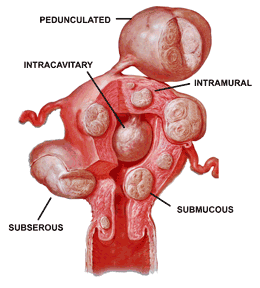Fibroids
I HAVE REMOVED:
- A basketball sized Fibroid Tumor in a woman extending all the way to her ribcage
- 14 separate tumors from one woman using a combination of special techniques to minimize bleeding
- Fibroid tumors through the Hysteroscope and Laparoscope since the 1990s
Sometimes Fibroid removal is desirable
to enhance fertility, reduce pain or bleeding
but most of the time
if a woman is having no symptoms,
I reassure her that no treatment is necessary
Raymond C. Lackore MD

- DIAGNOSIS: is usually based on finding of a larger than average sized uterus with an irregular surface during a pelvic examination. Ultrasound may be helpful to reveal the number and location of tumors. MRI or CAT scans usually do not show further useful information or improve outcome.
- SYMPTOMS: 10-40% of leiomyomata are associated with symptoms. Abnormal Heavy Uterine Bleeding, Pelvic Pain or Pressure, Lower Urinary Tract Complaints, or Infertility are most common. It is symptoms that usually determine treatment.
- MANAGEMENT: Most fibroid tumors do not cause symptoms. These are usually followed over time. Mild symptoms lead to treatments with medicine rather than surgery (see below). These tumors are responsible for an many major and minor conservative surgical procedures (dilation and curettage, hysteroscopy, endometrial ablation and myomectomy). Fibroids the most common reason for hysterectomy, causing approximately 30% of all such procedures in the United States. Hysterectomy can often be avoided.
FIBROID EVALUATION: History, Physical Examination, Ultrasound, Lab (Hgb/Hct), Endometrial sampling are the main steps to evaluation.
FIBROIDS AND CANCER: Approximately 1 in 1,000 fibroids have cancer called leiomyosarcoma (over 99.9% do not). It is believed these rare cancers do not growth from existing fibroids.
FIBROID TREATMENT: Many treatments are available and are based on symptoms caused by the tumor and a women’s goals. Also important is size, location, age, whether childbearing is complete, how close to menopause and what treatments the provider has best results with and are available in the community.
TREATMENT OPTIONS:
1. Watchful waiting: for worsening symptoms and growth. Involves rechecking every 6-12 months.
2. Medical Treatments:
…..Motrin or Aleve: May reduce bleeding and mild pain.
…..Low-dose Birth Control Pills: May reduce bleeding and pain. Do not cause tumor growth.
…..Iron Supplement: to manage anemia.
…..Mirena IUD: Likely to reduce bleeding and pain. Provides contraception. Fails if uterine cavity too distorted by a fibroid.
…..GnRH agonists: (Lupron) Many Side effects, high cost, short duration of use, May shrink the tumor before surgery. Tumors recur.
3. Surgical Treatments:
…..Endometrial Ablation: Minor procedure stops all bleeding in 50% of women reduces it to normal in another 30%. NOT FOR WOMEN WHO WANT CHILDBEARING. Usually a minor outpatient procedure. Less effective with large tumors.
…..Hysteroscopic Removal: 16% require reoperation within 9 yrs. Fertility effect excellent.
…..Laparoscopic or Abdominal incision Removal: Removal of Just the tumor.
…..Laparoscopic Hysterectomy: Usually by Minimally Invasive Technique – Extremely high “cure” rate. Stops ALL bleeding.
…..Myolysis – A needle is inserted into the fibroids, usually guided by laparoscopy, and electric current or freezing is used to destroy the fibroids.
4. Uterine Artery Embolization: (UAE or UFE). Within 3-5 years 20 to 30 % of patients need another treatment. Up to 10 % complication rate, 2% hospitalized. Ask the Radiologist about the “post embolization syndrome” – marked pain after the procedure. For an experienced local Radiologist who does this look at www.ufecenter.com/ (I have no business affiliation). Embolization is occasionally compatible with future childbearing. Fibroid embolization failure is highest in women < 40 years old or who have had a prior myomectomy.
5. HIFU: (MRI focused high-intensity ultrasound). Just treats the center of the tumor. Takes up to three hours to build up heat. FDA approved. Not available locally.
FOR AN EXCELLENT WEBSITE ON UTERINE FIBROIDS: visit WomensHealth.Gov

